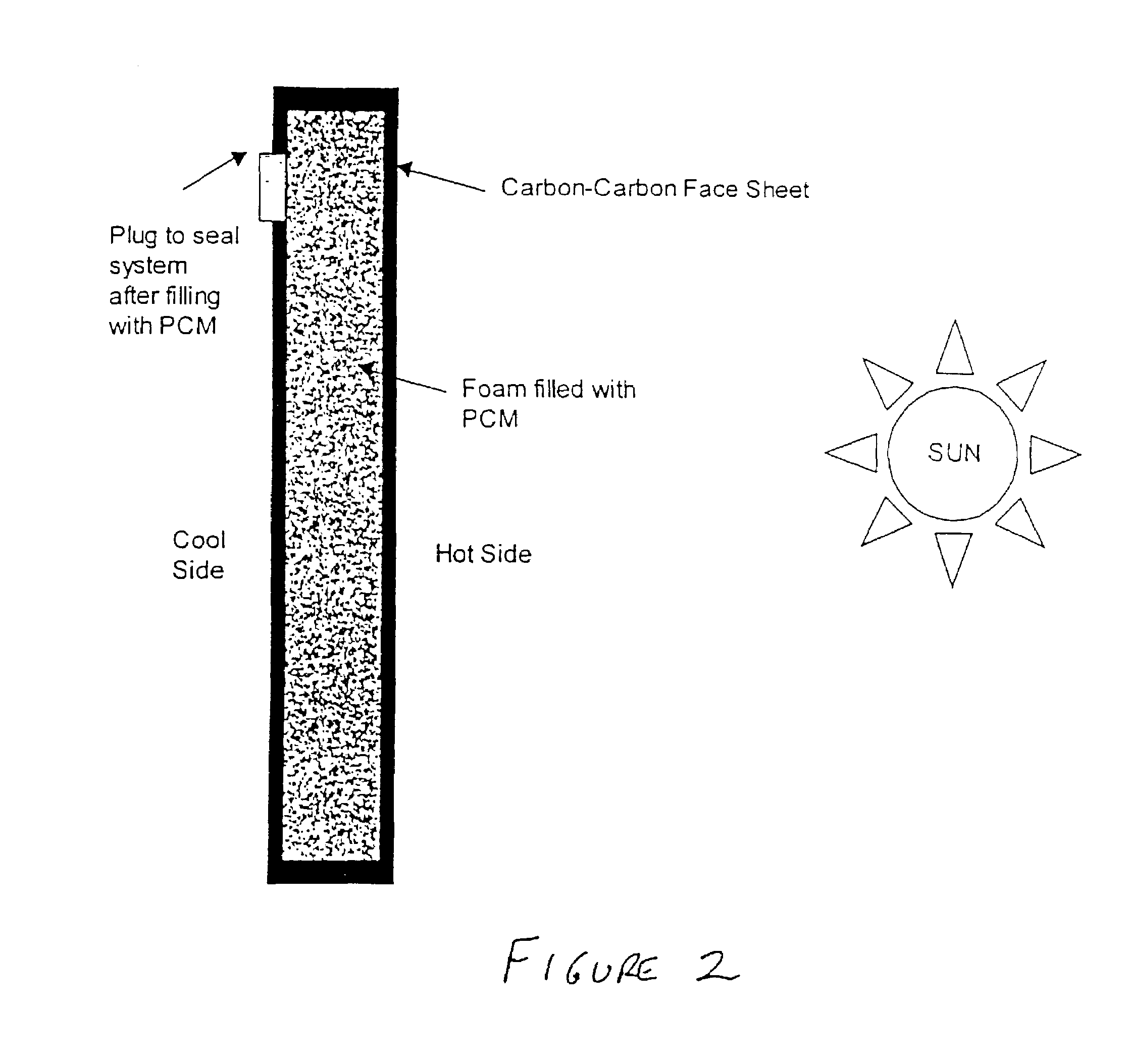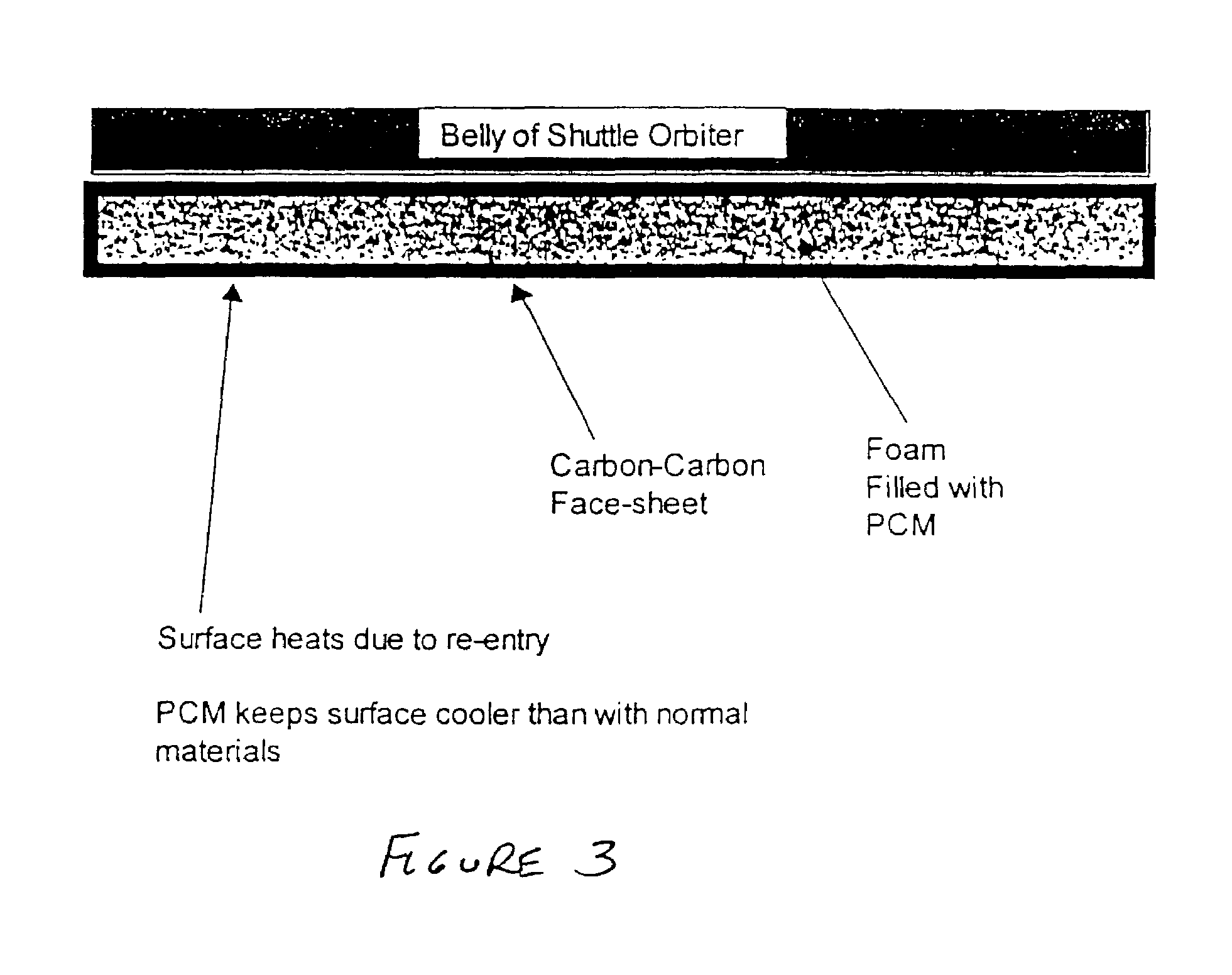Pitch-based carbon foam heat sink with phase change material
a carbon foam and heat sink technology, applied in the field of porous carbon foam filled with phase change materials, can solve the problems of insufficient heat flux of hot objects, inability to use certain applications, and insufficient heat flux for all, and achieve the effect of high thermal conductivity and rapid emitted hea
- Summary
- Abstract
- Description
- Claims
- Application Information
AI Technical Summary
Benefits of technology
Problems solved by technology
Method used
Image
Examples
example 1
Device for Thawing Food
[0036]Acetic acid has a heat of melting of 45 J / g at a melting point of 11° C. The heat of melting of food, primarily ice, is roughly 79 J / g at 0° C. Therefore, take a block of foam and fill it with liquid acetic acid at room temp. The foam will be encased in a box made from an insulating polymer such as polyethylene on all sides except the top. The top of the foam / acetic acid block will be capped with a high thermal conductivity aluminum plate that snaps into place thus sealing the foam / acetic acid inside the polymer case (illustrated in FIG. 1). If the foam block is 10-in.×15-in.×0.5-in. thick, the mass of foam is 614 grams. The mass of acetic acid that fills the foam is roughly 921 grams. Therefore, when a piece of frozen meat is placed in contact with the top of the aluminum block, the foam will coot to the freezing point of the acetic acid (11° C.). At this point, the heat given off from the acetic acid as it freezes (it also remains at 11° C.) will be eq...
example 2
Heat Sink To Prevent Overheating of Satellites During Cyclic Orbits.
[0037]Produce a carbon-carbon composite with the foam in which the foam is a core material with carbon-carbon face sheets (FIG. 2). Fill the foam core with a suitable phase change material, such as a paraffin wax, that melts around the maximum operating temperature of the satellite components. One method to perform this would be to drill a hole in one surface of the carbon-carbon face sheets and vacuum fill the phase change material in the liquid state into the porous foam. Once filled, the sample can be cooled (the phase change material solidifies) and the hole can be plugged with an epoxy or screw-type cap. The epoxy and any other sealant must be able to withstand the operating temperature of the application. The foam-core composite will to then be mounted on the side of the satellite that is exposed to the sun during orbit. As the satellite orbits the earth and is exposed to the sun, the radiant energy from the s...
example 3
Heat Sink for Leading Edges
[0038]Currently, the shuttle orbiter experiences extreme heats during reentry. Specifically, the leading edges of the craft can reach 1800° C. and the belly of the craft can reach temperatures as high as 1200° C. If a foam core composite panel is placed at the surface of the leading edges and at the surface of the belly (FIG. 3), it would be able to absorb enough energy to dramatically reduce the maximum temperature of the hot areas. This also would permit a faster re-entry or (steeper glide slope) and maintain the current maximum temperatures. In this case the phase change material would most likely be an alloy, e.g. germanium-silicon, which melts around 800–900C. and does not vaporize until much higher than the maximum temperature of the craft.
[0039]For example, Germanium has a heat of formation (heat of melting) of 488 J / g. This would require 1.0 Kg of Germanium to reduce the temperature of 1 Kg of existing carbon / carbon heat-shield by 668° C. In other ...
PUM
| Property | Measurement | Unit |
|---|---|---|
| temperature | aaaaa | aaaaa |
| temperature | aaaaa | aaaaa |
| temperature | aaaaa | aaaaa |
Abstract
Description
Claims
Application Information
 Login to View More
Login to View More - R&D
- Intellectual Property
- Life Sciences
- Materials
- Tech Scout
- Unparalleled Data Quality
- Higher Quality Content
- 60% Fewer Hallucinations
Browse by: Latest US Patents, China's latest patents, Technical Efficacy Thesaurus, Application Domain, Technology Topic, Popular Technical Reports.
© 2025 PatSnap. All rights reserved.Legal|Privacy policy|Modern Slavery Act Transparency Statement|Sitemap|About US| Contact US: help@patsnap.com



